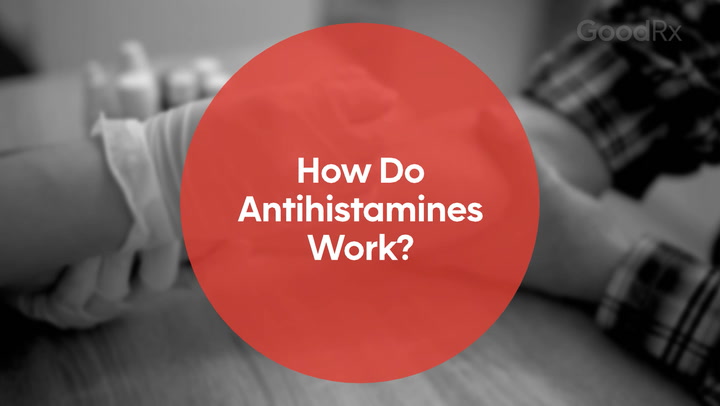
Benadryl, Claritin, and Zyrtec: Do Antihistamines Raise Blood Pressure?
Key takeaways:
Antihistamines like diphenhydramine (Benadryl), cetirizine (Zyrtec), and loratadine (Claritin) aren’t known to raise blood pressure when used alone. The same is true for fexofenadine (Allegra Allergy) and hydroxyzine (Vistaril, formerly Atarax).
Antihistamines are part of many combination over-the-counter (OTC) cough and cold products. These products often include medications that can increase blood pressure. Examples include ibuprofen (Advil, Motrin), acetaminophen (Tylenol), and pseudoephedrine (Sudafed).
Blood pressure increases from combination cough and cold products are often mild. But if you have high blood pressure, you may need to avoid all medications that can increase blood pressure. So talk to a healthcare professional before taking an OTC medication.
Access savings on related medications
Table of contents

Antihistamines are a broad group of medications. They treat symptoms of common medical conditions like allergies and colds. Many antihistamines — like diphenhydramine (Benadryl, Zzzquil), cetirizine (Zyrtec), and loratadine (Claritin) — are found over the counter (OTC).
Antihistamines are widely used. But they may not be the best option for everyone. For example, it’s a good idea for people ages 65 and older to avoid Benadryl. It can cause excessive drowsiness and confusion, which makes falls and injury more likely in this age group.
If you take antihistamines, you may wonder if they can cause high blood pressure. After all, many OTC and prescription medications can have this effect. But are antihistamines one of them?
What are antihistamines?
Antihistamines are a group of medications that treat many conditions. This includes seasonal allergies, insomnia (trouble sleeping), and cold symptoms.
Antihistamines work by blocking the histamine receptor. Histamine is a natural chemical that’s released when your body is triggered by an allergen or irritant. The release of histamine creates symptoms like a runny nose, itchy eyes, and sneezing. So when antihistamines block the histamine receptor, histamine can’t have its usual effects.
Many antihistamines are found OTC. They can be divided into three groups:
First-generation antihistamines, such as Benadryl, doxylamine (Unisom SleepTabs), and hydroxyzine (Vistaril, formerly Atarax)
Second-generation antihistamines, such as cetirizine, loratadine (Claritin), and desloratadine (Clarinex)
Third-generation antihistamines, such as fexofenadine (Allegra Allergy)
Comparing options: Pharmacists discuss some of the most common antihistamines and what sets them apart from one another.
Understanding side effects: Drowsiness and headaches are notable antihistamine side effects, but they’re more likely to happen with some antihistamines than others.
Is there a nondrowsy Benadryl? No. But there are other nondrowsy antihistamines to consider.
First-generation antihistamines work quickly to relieve allergies and cold symptoms. They don’t last long, so multiple doses per day may be required. But one of their most common side effects is drowsiness. For this reason, they’re sometimes also used to help people sleep. Second- and third-generation antihistamines take a little longer to start working. They also tend to have fewer side effects and last longer in the body. So they’re often taken once a day only.
Do antihistamines raise blood pressure?
Oral antihistamines, such as Benadryl, Zyrtec, and Claritin, aren’t known to increase blood pressure. Other antihistamine forms also aren’t known to have a major effect on blood pressure. This includes azelastine nasal spray (Astepro, Astepro Allergy) and eye drops and olopatadine eye drops (Pataday products) and nasal spray.
Do combination cough and cold products increase blood pressure?
Oral antihistamines are often part of OTC combination cough and cold products. Even if antihistamines don’t affect blood pressure, other ingredients in these products might. These products include:
Pain relievers, such as acetaminophen (Tylenol) and ibuprofen (Advil, Motrin)
Oral decongestants, such as pseudoephedrine (Sudafed)
Nasal decongestants, such as Afrin (oxymetazoline)
Read more like this
Explore these related articles, suggested for readers like you.
Examples of combination products that contain these medications include:
Allegra-D Allergy and Congestion (fexofenadine / pseudoephedrine)
Zyrtec-D (cetirizine / pseudoephedrine)
Claritin-D (loratadine / pseudoephedrine)
Advil Allergy and Congestion Relief (chlorpheniramine / ibuprofen / phenylephrine)
Tylenol Cold + Flu + Cough Night (acetaminophen / dextromethorphan / doxylamine / phenylephrine)
These products are available under many other brand names. So make sure you read the medication label carefully when buying an OTC medication. If you’re not sure, ask a pharmacist. They can help you understand what ingredients are part of any OTC product.
Blood pressure increases from these products are usually minimal. So if you don’t have high blood pressure, these OTC products probably won’t cause blood pressure problems. But if you already have high blood pressure, you may need to be more careful. Talk to a healthcare professional before trying OTC products in this case.
How much will blood pressure increase after taking combination products with antihistamines?
It’s unlikely that your blood pressure will increase when taking antihistamines alone. But combination products with ibuprofen, acetaminophen, or decongestants may raise blood pressure.
These medications affect everyone differently. But we have some research on what you can typically expect. For example, acetaminophen may increase blood pressure by up to 5 mmHg (millimeters of mercury). Ibuprofen may increase blood pressure by 3 mmHg to 4 mmHg. Pseudoephedrine has been found to raise blood pressure by about 1 mmHg.
Keep in mind that certain factors can make blood pressure increases more likely. For example, the study that showed acetaminophen can increase blood pressure by 5 mmHg was for individuals who already had high blood pressure. And they were taking the maximum recommended dose of acetaminophen (4 g daily). Most people take less than this. Lower doses may not have as large of an effect on blood pressure.
Blood pressure increases from these products are usually minimal. So if you don’t have high blood pressure, these OTC products probably won’t cause blood pressure problems. But if you already have high blood pressure, you may need to be more careful. Talk to a healthcare professional before trying OTC products in this case.
What side effects are common with antihistamines?
First-generation antihistamines generally cause more side effects than second-generation antihistamines. Common side effects seen with first-generation antihistamines include:
Sleepiness
Dizziness
Constipation or diarrhea
Headache
Trouble with coordination
Dry mouth
Dry eyes
Urinary problems (like trouble peeing)
These side effects may be possible with second- and third-generation antihistamines, but they’re less common.
The bottom line
Antihistamines help relieve symptoms of various medical conditions, like allergies and common colds. Examples include diphenhydramine (Benadryl, Zzzquil), cetirizine (Zyrtec), and loratadine (Claritin).
On their own, antihistamines don’t raise your blood pressure. But they’re often part of combination products with other ingredients that can raise your blood pressure. This includes ingredients such as ibuprofen (Advil, Motrin), acetaminophen (Tylenol), and pseudoephedrine (Sudafed).
Blood pressure increases with these medications are often mild. But they can be more problematic if you have high blood pressure already.
Why trust our experts?



References
American Academy of Allergy, Asthma and Immunology. (2024). Histamine defined.
MacIntyre, I. M., et al. (2022). Regular acetaminophen use and blood pressure in people with hypertension: The PATH-BP trial. Circulation.
Morrison, A., et al. (2007). Systematic review of trials of the effect of continued use of oral non-selective NSAIDs on blood pressure and hypertension. Current Medical Research and Opinion.
Salerno, S. M., et al. (2005). Effect of oral pseudoephedrine on blood pressure and heart rate: A meta-analysis. Archives of Internal Medicine.
Spence, J. D., et al. (2022). Acetaminophen, nonsteroidal anti-inflammatory drugs, and hypertension. Hypertension.





























